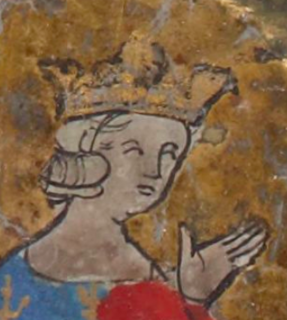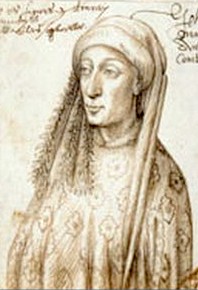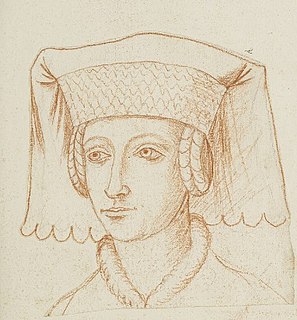
The Duke of Brabant was the ruler of the Duchy of Brabant since 1183/1184. The title was created by the Holy Roman Emperor Frederick Barbarossa in favor of Henry I of the House of Reginar, son of Godfrey III of Leuven. The Duchy of Brabant was a feudal elevation of the existing title of landgrave of Brabant. This was an Imperial fief which was assigned to Count Henry III of Leuven shortly after the death of the preceding count of Brabant, Herman II of Lotharingia. Although the corresponding county was quite small its name was applied to the entire country under control of the dukes from the 13th century on. In 1190, after the death of Godfrey III, Henry I also became duke of Lotharingia. Formerly Lower Lotharingia, this title was now practically without territorial authority, but was borne by the later dukes of Brabant as an honorific title.

Henry II of Brabant was Duke of Brabant and Lothier after the death of his father Henry I in 1235. His mother was Matilda of Boulogne.

Anthony, Duke of Brabant, also known as Antoine de Brabant, Antoine de Bourgogne and Anthony of Burgundy, was Count of Rethel (1402–1406), Duke of Brabant, Lothier and Limburg (1406–1415), and Co-Duke of Luxemburg (1411-1415). He was killed at the battle of Agincourt.

Marie of Brabant was Queen of France from 1274 until 1285 as the second wife of King Philip III. Born in Leuven, Brabant, she was a daughter of Henry III, Duke of Brabant, and Adelaide of Burgundy.

John IV, Duke of Brabant was the son of Antoine of Burgundy, Duke of Brabant, Lothier and Limburg and his first wife Jeanne of Saint-Pol. He was the second Brabantian ruler from the House of Valois. He is best known for founding the Old University of Leuven in 1425.

Philip I, also known as Philip of Saint Pol, was the younger son of Antoine, Duke of Brabant and Jeanne of Saint-Pol. He succeeded his brother John IV as Duke of Brabant in 1427, while he had inherited Saint-Pol and Ligny as an appanage on the death of his maternal grandfather, Waleran III of Luxembourg, Count of Ligny, in 1415.
Joan, Countess of Saint-Pol and Ligny, called the Demoiselle de Luxembourg, was the ruling Count of Saint Pol and Count of Ligny in 1430.

Guy III of Châtillon, Count of Saint-Pol was a French nobleman, and was a younger son of Hugh I, Count of Blois, and Mary, Countess of Blois.
Marie of Luxembourg was a French princess, the elder daughter and principal heiress of Peter II of Luxembourg, Count of Saint-Pol and Soissons, and Margaret of Savoy, a daughter of Louis I, Duke of Savoy. She belonged to the French, cadet branch of a dynasty which had reigned as Dukes of Luxembourg, and whose senior line provided several Holy Roman Emperors, before becoming extinct in 1437.

The House of Valois-Burgundy, or the Younger House of Burgundy, was a noble French family deriving from the royal House of Valois. It is distinct from the Capetian House of Burgundy, descendants of King Robert II of France, though both houses stem from the Capetian dynasty. They ruled the Duchy of Burgundy from 1363 to 1482 and later came to rule vast lands including Artois, Flanders, Luxembourg, Hainault, the county palatine of Burgundy (Franche-Comté), and other lands through marriage, forming what is now known as the Burgundian State.

Matilda of Brabant was the eldest daughter of Henry II, Duke of Brabant and his first wife Marie of Hohenstaufen.
Maria of Swabia was a member of the powerful Hohenstaufen dynasty of German kings.
Marie of Brittany (1268–1339) was the daughter of John II, Duke of Brittany, and Beatrice of England. She is also known as Marie de Dreux.
Margaret of Baux was a Countess of Saint-Pol, of Brienne, and of Conversano. She was a member of the noble House of Baux of the Kingdom of Naples, which had its origins in Provence dating back to the 11th century. Her husband was Peter of Luxembourg, Count of Saint-Pol, of Brienne, and of Conversano.

Margaret of Savoy, also known as Marguerite de Savoie or Margherita di Savoia, was the eldest surviving daughter of Louis I, Duke of Savoy. She was the wife of Margrave John IV of Montferrat, and later the wife of Peter II of Luxembourg, Count of Saint-Pol, of Brienne, Marle, and Soissons.

Marguerite d'Enghien, was the ruling suo jure Countess of Brienne and of Conversano, suo jure Lady of Enghien, and Lady of Beauvois from 1394 until an unknown date.
Peter of Luxembourg was a son of John of Luxembourg, Lord of Beauvoir, and his wife Marguerite of Enghien. His inheritance included the counties of Brienne, Conversano and Saint-Pol.
Guy I of Luxembourg-Ligny was Count of Saint-Pol (1360–1371) and Count of Ligny, Lord of Roussy and Beauvoir (1364–1371).
John of Béthune was a French nobleman and military leader in the County of Artois.
Maud Holland, also known by her titles through marriage as Lady Courtenay and Countess of St Pol, was an English noblewoman. She was a daughter of Thomas Holland, 1st Earl of Kent and Joan of Kent. After Thomas' death Joan married Edward the Black Prince, who was then Prince of Wales. One of Joan and Edward's sons was the future King of England, Richard II. When she was aged around eight Edward arranged a marriage for Maud to Hugh Courtenay, whom she married, with royal and papal approval. Her husband, with whom she had no children, died in 1374. Maud was one of the first women to be invested as ladies of the Order of the Garter, when Richard II appointed many of his relatives to the order in 1378. In 1380 Maud married Waleran III, Count of Ligny, a French nobleman. After her death she was apparently buried in Westminster Abbey but the location of her grave is not known.










